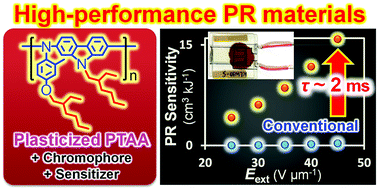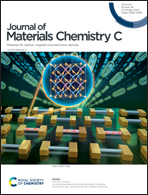High-performance organic photorefractive materials containing 2-ethylhexyl plasticized poly(triarylamine)†
Abstract
We have developed high-performance photorefractive (PR) materials containing ternary composites of 2-ethylhexyl plasticized poly(triarylamine) (PTAA), a chromophore, and a photosensitizer. PTAAs containing carbazole or fluorene in a main chain and 2-ethylhexyl in a side chain are synthesized via palladium-complex catalyzed polyamination. The spectroscopic, thermal, and hole-transport properties of these polymers are analysed. The carbazole-containing polymer shows good compatibility with chromophores, affording the high chromophore loading of polymer/chromophore = 70/30 wt%. This polymer can be utlilised in PR devices as a host material without any additional plasticizer. The PR performance of a polymer/chromophre/sensitizer (69/30/1 wt%) composite was evaluated using an optical four-wave mixing technique (FWM) to determine the change in refractive index Δn and the average-response time constant τ. This composite exhibits results comparable to the inorganic crystals BSO or SPS when the optical sensitivity is maximized at 15.8 cm3 kJ−1, with Δn = 5.3 × 10−4 and τ = 2 milliseconds under a pump-laser intensity of 149 mW cm−2. This is one of the highest values obtained for an organic PR composite with a pump laser operating at 633 nm.



 Please wait while we load your content...
Please wait while we load your content...